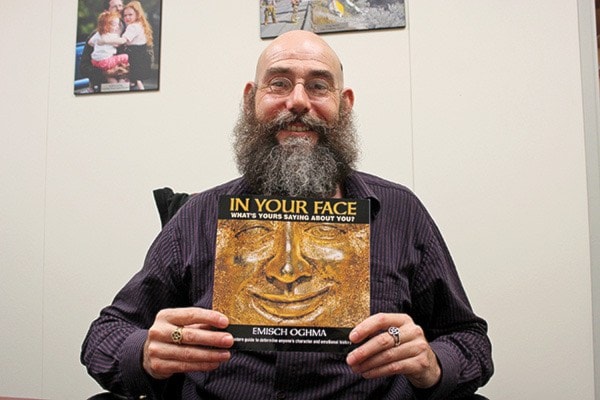When Emisch Oghma looks at someone’s face, he doesn’t just see their features, but is able to look into their past, present and future.
The Esquimalt resident examines people’s faces, looking at the shape of their eyes, nose, mouth, as well as their features and expressions. Based on the shape of one’s head or marks on one’s face, Oghma is able to tell if someone is an enthusiastic go-getter, stable and pragmatic, emotional and compassionate, or forgiving and caring.
Oghma is also able to determine if someone has experienced more happiness, sadness or hardship in their life, when they first loved and how deeply it hurt them, along with their entire emotional history, just by looking at someone’s face.
“As soon as we’re born until we die our face records every emotion we’ve ever had. It’s recorded in the muscle memory in our face. The more repetitious emotions, the more that same muscle configuration (occurs),” said Oghma, adding the act of reading one’s face is similar to palm reading.
“The placement of the structure of the face, the features of the face, the lines and marks, all come from reaction to an emotion we’ve had . . . there is a science.”
To study people’s faces, Oghma uses the ancient Chinese face reading system called siang mien, which is the topic of his new book, In Your Face.
The siang mien system was created thousands of years ago, in which masters isolated facial shapes, features and contours into categories, inspired by the four elements of air, fire, water and earth. After centuries of observations, they could attribute a meaning or pattern to each facial characteristic.
It’s a skill Oghma learned after he fell off a balcony at work and suffered a severe brain injury in Victoria. The injury went undiagnosed for nearly two years, before doctors told him he suffered from agnosia — the inability to recognize and identify objects or people.
Originally a visual artist who dabbled in photography, Oghma was known for being out going, entrepreneurial and had an eidetic memory. But that was ripped from him with the diagnosis.
In the first few months, Oghma would meet people and have great conversations with them, but wouldn’t recognize them the day after. While he was quick to tell people he had a brain injury, Oghma admitted he started to lose friends after his accident.
But he was determined to rebuild his mental capacities and raise his two young sons. It was then Oghma’s brother introduced him to a book about siang mien. He began studying the system, going to the same coffee shop every week for almost eight years, and slowly but surely was able to identify people based on their facial features and used it as ways to remember them.
The step by step process of reading someone’s face is outlined in his new 45-page book. While Oghma believes it’s a fun book that will be a conversation piece for people’s coffee tables, he hopes the ability to read one’s face makes people more compassionate as well.
“The end game, what it (face reading) helps us is become more compassionate from where someone else has been. We start to see the character lines of their past emotional situations that they were involved in. They’re theirs, they’ve earned them,” Oghma said. “It’s not for us to judge them or not, but we can read them.”
In Your Face can be purchased on Amazon. An e-book edition is also available. For more information visit emischoghma.com.
Kendra.wong@vicnews.com
